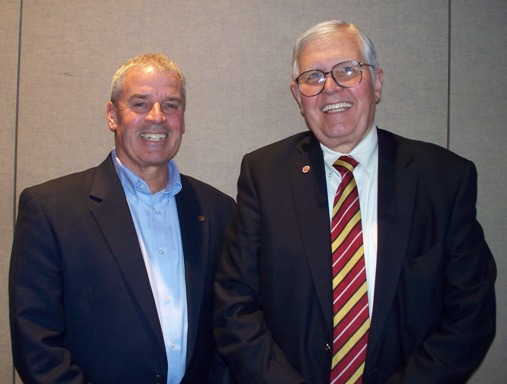JAN 22, 2013 ROTARY IN REVIEW:
Don Ganje, Great River Passage
President Dan McKeown called the meeting to order at 12:30 p.m. Jerry Faletti led a vigorous rendition of America the Beautiful, accompanied by Bill Given on the piano (with a characteristic trill on the final note for extra polish!)
Tom Brinsko offered an unflappable delivery of a patriotic and spiritual invocation, despite the worst intentions of an overly-sensitive touch screen and its continual beeping.
President Dan recognized greeters Mike Anderson and Andy Currie and Scribe Michael-jon Pease.
Vicki Gee-Treft introduced visiting Rotarians and guests, including Carley Stuber, a prospective member from the Children’s Museum presented by Mindee Kastelic and Dominic Lawrence, the new Director of Gift Planning at the St. Paul Foundation, presented by Jeremy Wells.
Blaine Niven introduced the new member challenge. We are currently 20 members away from our goal of 200 members for 2013. The Rotarian who brings on the most new members between now and March 15 can choose between two prizes: MN Wild Hockey tickets (on the glass, including food and beverage) or VIP passes to Park Square Theatre. Every Rotarian who brings in a new member during the new member challenge will also receive a 12-pack of Summit Beer to share with your new recruit, courtesy of Mark Stutrud.
 Paul Verret introduced new member Tom Holland, a 20-year Rotarian who has taken Barbara Nichols post at People, Incorporated.
Paul Verret introduced new member Tom Holland, a 20-year Rotarian who has taken Barbara Nichols post at People, Incorporated.
Doug Hartford mentioned that the Foundation Annual Report for 2012 is now available online, or via hard copy from Sherry for those who “eschew technology.”
Sarah Kolar led a lively round of Happy Dollars, including mentions from Vicki Gee-Treft (Don’t miss Tornado Alley and Body Worlds!); Jerry Faletti (who just ended a historic 5-week hiatus from Rotary meetings); Ken Crabb (thanks for treating his son so well when he visited to pitch his club’s upcoming Glorious Glasses fundraiser); Captain Jim Kosmo (thanks for the extra copies of Rotarian Magazine – now all the kids and grandkids have copies of his feature); Sherry (promoting Winter Carnival Buttons on behalf of Molly Boyne – just $5/button or $19/4 pack).
Jim Miller introduced the day’s speaker – Dan Ganje from Saint Paul Parks Department. Jim offered the important geological fact that 10,000 St. Anthony Falls was half the size of Niagra Falls and located in Saint Paul. If the river bed were made of long-lasting granite instead of shifting sand and limestone, then our capital city would be a major hub of hydraulic powered mills and industry and Minneapolis would be a quiet suburb similar to Coon Rapids. It pays to understand your geological fate!
Dan unveiled the plans for the Great River Passage, part of the 30-year master plan for Saint Paul’s 17 miles of Mississippi riverfront.
The key goals of the plan are to make the riverfront more natural, more urban and more connected to the community.
“More Natural” refers to the availability of outdoor recreation and environmental experience.
To make the area “more urban” the plan envisions a series of gathering places along the river where people can meet their neighbors and “touch” the water.
Three key areas slated for development include:
Waterfront Marina (currently a private marina), which will be revitalized as a recreation center offering canoes, bikes, fishing gear and tackle, an expanded marina and an environmental education center.
Downtown Riverview Balcony (encompassing the former jail site on Kellogg). Similar to Highline Park in Manhattan, this linear strip of riverfront and its trails will link the Science Museum, the jail, the old West Publishing building, with the Post Office and Union Depot. Bike trails will continue all the way to Stillwater.
Island Station (the former NSP plant at Randolph and Shepard). This would become a park hub with ice skating and climbing, water sports and gathering places.
To make the river “More Connected” to neighborhoods, Shepard Road will be remade into a more pedestrian friendly modified parkway, with narrower lanes, slower speeds and bike lanes. Overall, the plan will fill in gaps to link existing trails, expand greenspace, add native plants and manage invasive species, and add public art that references historic, natural and community elements of key areas. Learn more (and see the short video shown at the meeting) at http://www.greatriverpassage.org/
Michael-jon Pease, Scribe

